Excessive and in some cases, abusive rainfall amounts; keys to soggy turfgrass management; winter injury potential causes and recovery, red thread, spring golf disease prevention
Weather
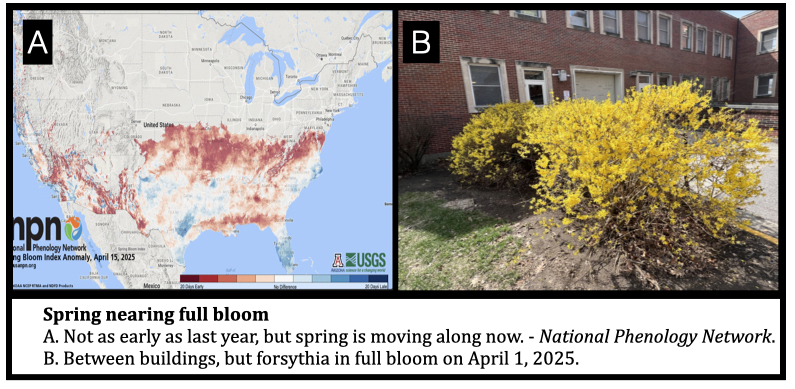
Spring, which officially started on March 20, is rolling along, and into mid-April temperatures in the region are ahead of statistical normal, but lagging somewhat behind last year. I appreciate and highly recommend the Growing Degree Day Tracker hosted by Michigan State University as a barometer for the progress of spring, and importantly the status of growing degree accumulation vs. the previous year. Flowering in the Lafayette area of the early bloomers has occurred, with forsythia leading the way and now dandelion flowers popping in yards throughout the area.
The winter of 2024-25 had near normal regional temperatures in the north and slightly below normal temperatures in the south. December was above normal, but with the new year came a marked shift in below normal temperatures in January and February. Importantly for us turfgrass managers, these frigid Arctic blasts were not accompanied by precipitation and snow cover. As noted below, we are getting reports and a few samples of winter injury on home lawns in northern IN as a result of this unprotected blast of cold air.
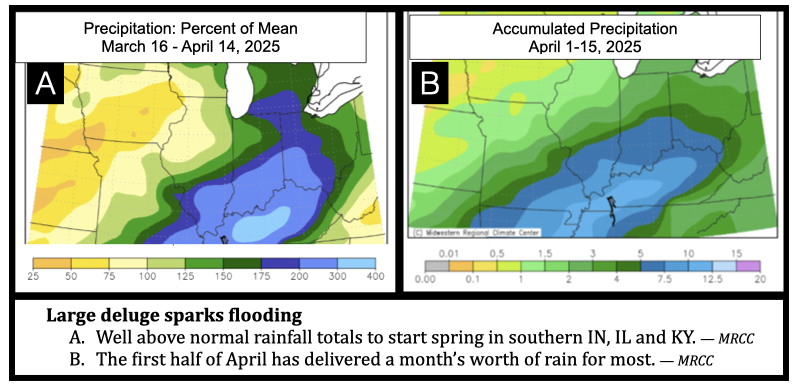
The story again this April has been extreme rainfall events and above average precipitation, particularly for southern Indiana, Kentucky and Ohio. Rainfall totals along the Ohio River Valley ranged from 7 – 15” in consistent storms starting on April 5th, resulting in severe flooding in the region. This adds on to a significant flooding event in Kentucky in mid-February. Fortunately, reports indicate the impact on turfgrass health has been manageable thus far, but not without considerable and noble efforts by golf superintendents, their crews and other turfgrass managers in the region.
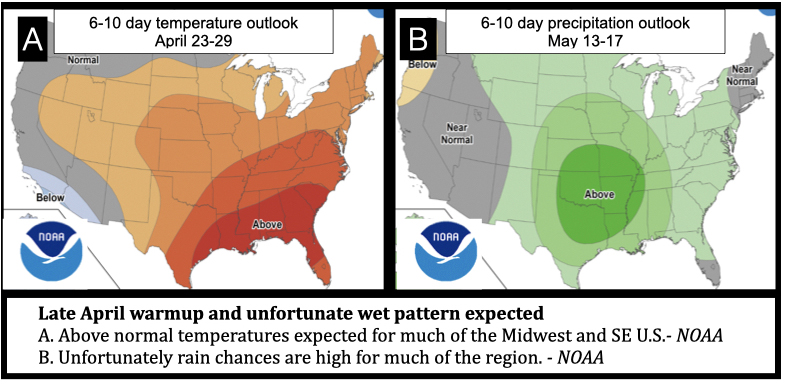
Forecasts indicate a rise in temperature through the end of the April and unfortunately, above normal expectations for rainfall throughout the region. As we enter this crucial management period for cool season turfgrasses, water, and its impact on turfgrass health later in the season, should be at the forefront of turfgrass managers’ minds.
Water
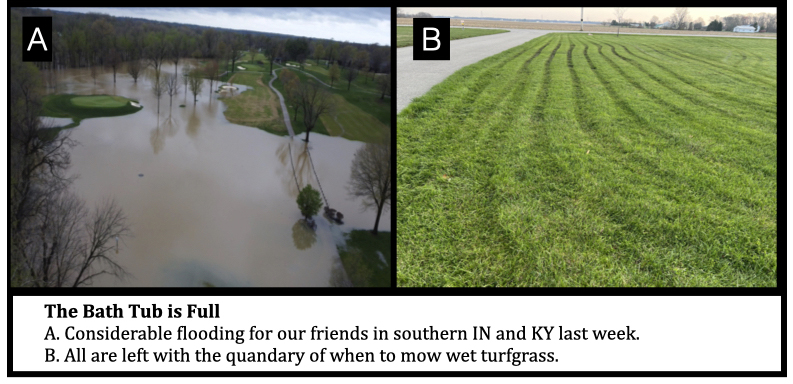
The region almost certainly won’t be in an excess rainfall scenario for the whole season and supplemental irrigation will likely be needed to keep turfgrass lush and green. Now, however, too much water can have negative consequences that last well into future months as cool season turfgrasses need to put down spring root growth to enter the marathon of summer. Below are a few thoughts on managing turfgrass in the current spring deluge.
Tolerance & Survival – A recent study done at Purdue by Drs. Braun and Patton investigated growth responses of cool season grasses to waterlogging stress (click here to view). They found many of the cool season turfgrasses we use in this region (Kentucky bluegrass, tall fescue and fortunately creeping bentgrass) have the highest waterlogging stress tolerance compared to other cool season species. The fine fescues, such as creeping red, Chewings and hard, had poor tolerance with our weeds annual and roughstalk bluegrass having fair tolerance to waterlogging. For warm season turfgrasses, Fry (1991) showed good submersion tolerance of bermudagrass and zoysiagrass in controlled studies. In field observations during flood events, bermudagrass performs considerably better than zoysiagrass.
Injury increases with depth of water and is higher under stagnant vs. moving water. If silt deposition occurs, removing it as quickly as possible with raking, hosing, power washing, etc. is extremely important for recovery. Lastly, water temperature was fortunately in our favor, as lower temperatures allow for much longer survival than water at higher summer temperatures. More information can be found about dealing with flood damage here – Reicher & Bigelow.
Mowing – Grass has been growing, which has necessitated mowing. In much of the region, at least one and more likely 2-3 mowings of lawns and roughs have occurred with many more likely on cool season greens, tees and fairways.
Timing of mowing around rain events is tough and a balancing act. Mow frequently enough to avoid scalping and baling hay, while also avoiding trafficking wet, saturated soils and creating muddy mower tracks. Trying to navigate this quandary while coordinating the maintenance of several, if not many, different properties under the purview of a landscape company can be near impossible. Inform your operators to avoid wet areas when they can, and if they do mow a wet area to map it for corrective aerification in the soil. Raise the decks as high as they will go. If mowing on wet soil, the machine will sink and equate to a lower mowing height. If an area needs to be skipped, manage the clippings in the subsequent mowing. Double cut to mulch, bag and remove, or simply blow and disperse clumps of clippings so they don’t smother turfgrass underneath and provide a perfect disease causing environment.
Manage the Water: This should be obvious, but lawn irrigation should not be running. I had a silent, but severe conniption upon witnessing a home lawn irrigation system running last week. Soil systems broadly throughout the region need to dry out. Most neighborhood lawns are built on substandard clay soils that dry slowly and are hard enough for roots to subsist in anyway. Roots need air to grow. This time frame is particularly important to allow deeper soil penetration by roots to manage the impending fickleness of summer precipitation. Let them have it.
One of the most important factors in disease development is free leaf moisture and high humidity. Most of the diseased lawn samples submitted to the Purdue Plant and Pest Diagnostic Lab are from areas with in-ground irrigation systems (IGS). Flash drought and collapse of plants caused by shortened, over-watered roots occur most often on irrigated lawns. The correlation is consistent and definitive. Use IGS sparingly and when needed. This isn’t the time.
Winter Injury on Lawns
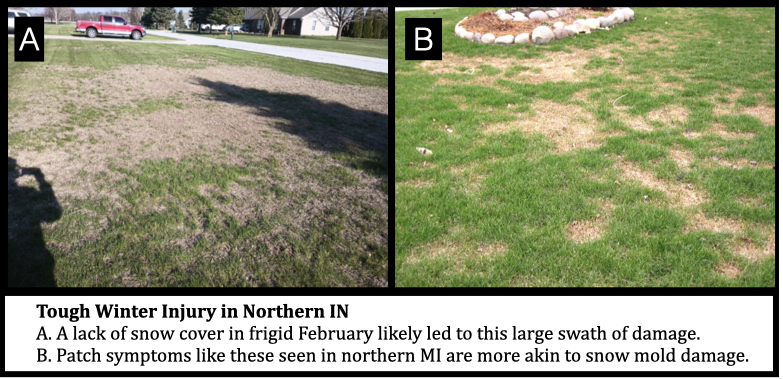
A few instances of winterkill on lawn grasses in northern Indiana have been reported and submitted to the lab. Winterkill isn’t an every season occurrence and deriving an exact reason for the damage after the fact is often difficult. I surmise this damage came in February when arctic temperatures combined with no snow cover for protection plunged soil temperatures to sub-freezing levels for 14+ days straight. Low temperature kill is most severe in perennial ryegrass, annual bluegrass and tall fescue. Farther up into Michigan with longer periods of persistent snow cover, snow mold diseases are more common. If Kentucky bluegrass is present, an option is to allow regrowth from rhizomes. If not, rake matted areas to assess damage and reseed as soon as possible. Two great articles regarding winterkill causes and recovery can be found from Purdue here and Michigan State here.
Red Thread/Pink Patch
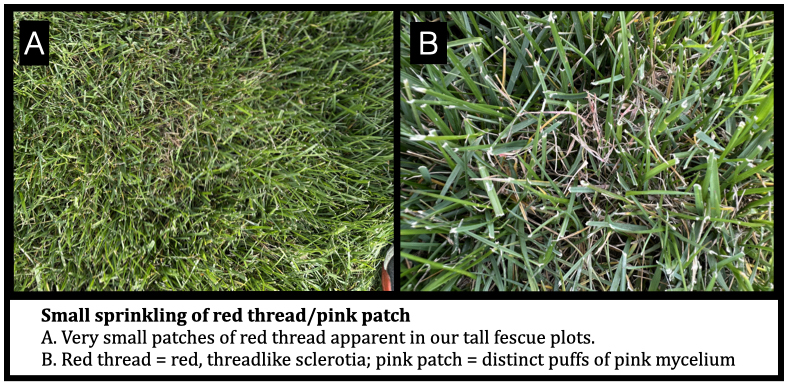
Upon scouting our tall fescue plots last week, we found small beginnings of the disease most commonly known as red thread. The disease is often associated with two pathogens: red thread caused by Laetisaria fuciformis which has the distinct red sclerotia threads, and pink patch caused by Limonomyces roseipellis which produces fluffy pink tufts of mycelia on leaf blades. Tall fescue, fine fescues, Kentucky bluegrass and perennial ryegrass are most commonly affected. In most cases, fungicides for red thread control aren’t warranted. Red thread occurrence is a sign that nitrogen from the previous year has run out and another dose is needed. Recent studies have shown good curative recovery from an application of 1 lb N/1000 sq ft. If the disease is extremely severe, azoxystrobin has also demonstrated good curative performance. For more information on this and other lawn diseases, see BP-218-W.
*Note – On lawns, preventive fungicide applications are too early and should not be initiated at this time.*
Golf Only: Disease Prevention – Large Patch & Soilborne Diseases on Putting Greens
All of this precipitation and warmer spring weather should turn our attention to root health of putting greens and protection from soilborne diseases. Now is a great time to identify deficiencies in drainage. Two-inch soil temperatures are nearing the 55 degree mark in southern IN and if the warmup forecast holds will be soon reached in Indianapolis. Consider firing up your fairy ring/patch targeted fungicide applications in the next two weeks, and with all of this rain don’t hold off too much longer on Pythium root rot prevention. Remember all of these applications targeting soilborne diseases will need to be irrigated in with at least 1/8 inch and preferably closer to 0.2 or ¼ inch of post-application irrigation to drive the fungicide down to the target zone.
Last but not least, zoysiagrass golf fairways (and lawns) with a history of large patch may require a spring preventive or early curative fungicide, particularly with the perfect environment caused by several, very imperfect spring storm systems.
SAVE THE DATE: Purdue Turfgrass and Landscape Field Day – Tuesday, July 8th
Extension Turfgrass Pathologist – Purdue University
Follow on Twitter: @purdueturfpath
Turfgrass Pathology Program Impact Survey

Follow this link or scan QR code above to access the survey.